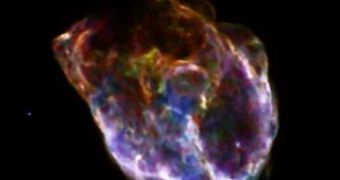The Large Magellanic Cloud is a small galaxy in the Local Group only 160,000 light years away from Earth. Recently, NASA's Chandra X-ray Space Observatory discovered a large supernova remnant that contains large amounts of oxygen. The N132D supernova remnant is part of an oxygen-rich remnant and the brightest feature observable in the Large Magellanic cloud. The oxygen found here on Earth most likely originated in similar supernovae explosions.
The X-ray image of the cloud reveals that substantial amounts of oxygen are present especially in the regions of the Magellanic cloud represented in green, towards the center of the image. This composite X-ray image shows the low energy X-ray emissions in red, while green is associated to intermediate X-ray image and blue, to high energy emissions.
Previously, the Hubble Optical Space Telescope detected similar oxygen-rich areas that seem to accurately match those found by Chandra. On the other hand, supernova remnants such as G292.0+1.8 and Puppis A, two of the best known SNRs in the Magellanic cloud, do not seem to present similar ellipse-shaped shells of oxygen as those in N132D, which is probably because N132D is about ten times older than Cas A (which is only 300 years old).
The creation of the oxygen shell might be due to a 'nickel bubble', which formed shortly after the supernova explosion, as a result of the radioactive energy radiated from the nickel remnants in the outcome of the explosion. Although such a scenario hasn't been tested, theoretical studies predict that similar bubble may form during a supernova explosion. Much of the research made into the study of supernova explosions are related to understanding how massive stars explode into supernovae and spread new heavy elements into the surrounding space, in addition to constraining the mass of the star that exploded.

 14 DAY TRIAL //
14 DAY TRIAL //